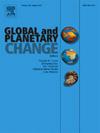Paleo-data is policy relevant: How do we better incorporate it in policy and decision making?
IF 4
1区 地球科学
Q1 GEOGRAPHY, PHYSICAL
引用次数: 0
Abstract
The relatively recent acceleration of human activities that adversely impact Earth's systems has led to an increasingly urgent impetus to understand, mitigate, and adapt to these impacts. However, comprehension of natural systems, and fluctuations in their state, requires long-term data to capture the magnitude and direction of changes in these systems over very long time frames (decades to millennia). The current reliance on short instrumental or monitoring time series, that span only the last century or less, is simply inadequate to sustainably manage natural systems. Despite this growing need for long-term information and the abundance of paleo-data available, there has been little effort or success in incorporating paleo-science into policy and decision making. We use examples to demonstrate how paleo-data provides important insights into problems from three different domains: forest management and restoration, water resource management and wetland ecosystem management. We discuss a process through which opportunities to better utilise paleo-data by policy decision makers to achieve better policy outcomes can be identified. This involves first acknowledging the very different characteristics of paleo-scientists and policy makers, followed by recognition of the constraints, or barriers to the uptake of paleo-science information. These barriers exist as much for scientists as for policy makers. Identification of barriers enables opportunities for enhanced collaboration to improve the use of paleo-data for policy and decision making to be identified. Fundamentally, much greater interaction between paleo-scientists and policy makers is required to promote better science translation, data availability as well as to promote scientific literacy in government and industry, and policy literacy in the paleo-science community. Processes such as co-design are one way to achieve these aims, but require adequate resourcing, time and the collective will to collaborate.
求助全文
约1分钟内获得全文
求助全文
来源期刊

Global and Planetary Change
地学天文-地球科学综合
CiteScore
7.40
自引率
10.30%
发文量
226
审稿时长
63 days
期刊介绍:
The objective of the journal Global and Planetary Change is to provide a multi-disciplinary overview of the processes taking place in the Earth System and involved in planetary change over time. The journal focuses on records of the past and current state of the earth system, and future scenarios , and their link to global environmental change. Regional or process-oriented studies are welcome if they discuss global implications. Topics include, but are not limited to, changes in the dynamics and composition of the atmosphere, oceans and cryosphere, as well as climate change, sea level variation, observations/modelling of Earth processes from deep to (near-)surface and their coupling, global ecology, biogeography and the resilience/thresholds in ecosystems.
Key criteria for the consideration of manuscripts are (a) the relevance for the global scientific community and/or (b) the wider implications for global scale problems, preferably combined with (c) having a significance beyond a single discipline. A clear focus on key processes associated with planetary scale change is strongly encouraged.
Manuscripts can be submitted as either research contributions or as a review article. Every effort should be made towards the presentation of research outcomes in an understandable way for a broad readership.
 求助内容:
求助内容: 应助结果提醒方式:
应助结果提醒方式:


